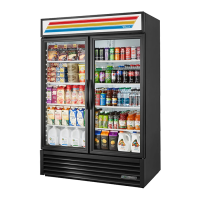100
COMPLAINT
F Unit operates long or
continuously
G Start capacitor open,
shorted, or blown
H Run capacitor open,
shorted, or blown
I Relay defective or
burned out
J Space temperature
too high
K Suction line frosted
or sweating
L Liquid line frosted or
sweating
M Unit noisy
POSSIBLE CAUSE
1. Shortage of refrigerant.
2. Control contacts stuck or frozen closed.
3. Refrigerated or air conditioned space has
excessive load or poor insulation.
4. System inadequate to handle load.
5. Evaporator coil iced.
6. Restriction in refrigeration system.
7. Dirty condenser.
8. Filter dirty.
1. Relay contacts not operating properly.
2. Prolonged operation on start cycle due to:
a. Low voltage to unit.
b. Improper relay.
c. Starting load too high.
3. Excessive short cycling.
4. Improper capacitor.
1. Improper capacitor.
2. Excessively high line voltage (110% of rated-
max.).
1. Incorrect relay.
2. Incorrect mounting angle.
3. Line voltage too high or too low.
4. Excessive short cycling.
5. Relay being influenced by loose vibrating
mounting.
6. Incorrect run capacitor.
1. Control setting too high.
2. Expansion valve too small.
3. Cooling coils too small.
4. Inadequate air circulation.
1. Expansion valve passing excess refrigerant or
is oversized.
2. Expansion valve stuck open.
3. Evaporator fan not running.
4. Overcharge of refrigerant.
1. Restriction in dehydrator or strainer.
2. Liquid shut-off (king valve) partially closed.
1. Loose parts or mountings.
2. Tubing rattle.
3. Bent fan blade causing vibration.
4. Fan motor bearings worn.
REPAIR
1. Fix leak, add charge.
2. Clean contacts or replace control.
3. Determine fault and correct.
4. Replace with larger system.
5. Defrost.
6. Determine location and remove.
7. Clean condenser.
8. Clean or replace.
1. Clean contacts or replace relay if necessary.
2a. Determine reason and correct.
2b. Replace.
2c. Correct by using pump down arrangement
if necessary.
3. Determine reason for short cycling (E
above) and correct.
4. Determine correct size & replace.
1. Determine correct size and replace.
2. Determine reason and correct.
1. Check and replace.
2. Remount relay in correct position.
3. Determine reason and correct.
4. Determine reason (See E above) and cor-
rect.
5. Remount rigidly.
6. Replace which proper capacitor.
1. Reset control.
2. Use larger valve.
3. Add surface or replace.
4. Improve air movement.
1. Readjust valve or replace with smaller
valve.
2. Clean valve of foreign particles, replace if
necessary.
3. Determine reason and correct.
4. Correct charge.
1. Replace part.
2. Open valve fully.
1. Find and tighten.
2. Reform to be free of contact.
3. Replace blade.
4. Replace motor.
WARNING: ELECTRICAL POWER MUST BE DISCONNECTED WHEN TERMINAL PROTECTIVE COVER NOT
IN PLACE TO PROTECTAGAINST ELECTROCUTION OR VENTED TERMINAL.
F
G
H
I
J
K
L
M
CFC & REFRIGERATION BASICS
Trouble Shooting and Service Chart ... Continued

